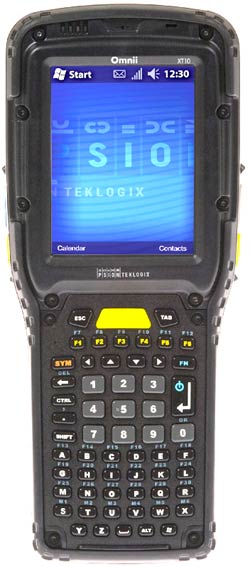For a while now Psion-Teklogix has been concerned about offering their customers the exact right handheld computer for a given job. This resulted in the "Modulus" concept (see here) that modularizes their hardware platforms as much as possible. Initially, the Modulus approach was limited to add-on and snap-on modules for their WORKABOUT, Ikôn and NEO handhelds, offering superior configurability, exchangeable components, as well as guarding against obsolescence and opening the platforms to development by using open standards. With their latest product, the Omnii XT10 introduced in September of 2010, Psion Teklogix went one step farther by making the entire platform modular.
 What that essentially means is that customers who like a particular form factor — in the new Omni XT10's case a full-size flashlight-style handheld — are not locked in to whatever display, keypad, data collection functionality or connectivity the device comes with.
What that essentially means is that customers who like a particular form factor — in the new Omni XT10's case a full-size flashlight-style handheld — are not locked in to whatever display, keypad, data collection functionality or connectivity the device comes with.
Instead, the system is almost completely modular, with customers able to opt for either a high-visibility or an extreme duty display; one of three very different keypads; one of no fewer than five imager/scanner options; as well as speaker, camera and pistol grip options. Modularity even extends to interface configuration where customers can select from multiple internal multi-function expansion interfaces with RS232 serial, USB host, and GPIO ports.
Quite clearly, this sort of modularity gives Psion-Teklogix customers a much greater selection, and the modular design allows Psion-Teklogix to fill such different configuration orders quickly and easily.
What doesn't change is the overall size and shape of the product, as well as the underlying guts and electronics. Physically, we're looking at a substantial device measuring about 9 x 4 x 1.65 inches and weighing two pounds, give or take an ounce or two with different configurations. The display is gratifyingly large (3.7 inches diagonal) and offers full 480 x 640 VGA resolution. The three available keyboard modules are sufficiently different to fill various needs, and they are large enough to be operated even with gloves on.
As far as technology goes, the Omnii XT10 runs Windows CE 6.0 on a 600MHz TI OMAP3 processor with an ARM Cortex A8 core (not clear which exact OMAP P3xxx chip is used). The device comes with 256MB of onboard SDRAM and 512MB of onboard Flash. A microSD slot can be used for memory expansion. A high-capacity 5,000 mAH rechargeable Lithium-Ion powerpack provides full-shift battery life.
Modularity extends to configuring the device in the front with an integrated speaker and microphone for push-to-talk and multimedia; a speaker/microphone with 3MP autofocus camera with flash; or a 1D imager. In the back, there can be a 1D imager, a 2D imager, or a 1D long-range laser scanner. Accessories can be a pistol grip that works with the chosen modules. The idea clearly is to offer customers exactly what they want and need, making things available that are needed for the job, but not forcing customers to pay for functionality they do not need.
Needless to say, the Omnii XT10 is a rugged device. It can handle extreme operating temperatures between -4 and 122 degrees Fahrenheit, passed the MIL-STD-810F test of 26 drops from 5.6 feet onto concrete, and also passed shock and vibration tests, as well as ESD tests. The device is sealed to IP65 specifications. This means it's totally sealed against dust and also protected against water jets from all directions.
Whenever a company adds a new model, the question comes up as to where it fits into the existing lineup, and whether it expands the lineup or simply replaces an existing product. There is often some overlap, and sometimes product replacement strategies are fluid. In the Omni XT10's case, this is clearly an addition to Psion-Teklogix's lineup. It's their biggest and most modular handheld, and one that fully adheres to the company's stated goal of offering flexibility, modularity and an open platform to their customers.



